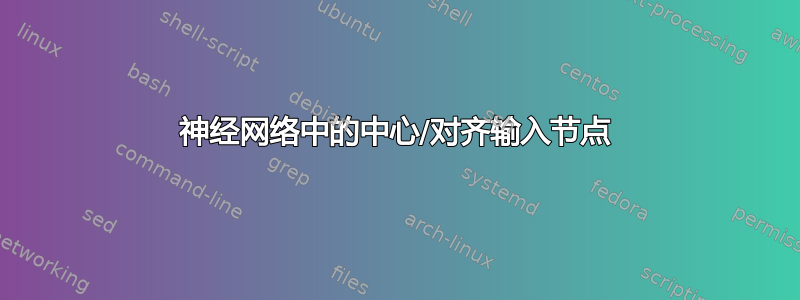
我有一个神经网络图,但是,正如您所看到的,输入节点并不以隐藏层和输出为中心。
我的 MWE:
\documentclass{article}
\usepackage{tikz}
\usepackage{float}
\usetikzlibrary{matrix}
\begin{document}
\begin{figure}[tbp!]
\begin{tikzpicture}[
plain/.style={
draw=none,
fill=none,
},
net/.style={
matrix of nodes,
nodes={
draw,
circle,
inner sep=10pt
},
nodes in empty cells,
column sep=2cm,
row sep=-9pt
},
>=latex
]
\matrix[net] (mat)
{
|[plain]| \parbox{1.3cm}{\centering Input\\layer} & |[plain]| \parbox{1.3cm}{\centering Hidden\\layer} & |[plain]| \parbox{1.3cm}{\centering Output\\layer} \\
& |[plain]| \\
|[plain]| & \\
& |[plain]| \\
|[plain]| & |[plain]| \\
& & \\
|[plain]| & |[plain]| \\
|[plain]| \\
|[plain]| & \\
|[plain]| \\
};
\foreach \ai [count=\mi ]in {2,4,...,6}
\draw[<-] (mat-\ai-1) -- node[above] {Input \mi} +(-2cm,0);
\foreach \ai in {2,4,...,6}
{\foreach \aii in {3,6,9}
\draw[->] (mat-\ai-1) -- (mat-\aii-2);
}
\foreach \ai in {3,6,9}
\draw[->] (mat-\ai-2) -- (mat-6-3);
\draw[->] (mat-6-3) -- node[above] {Ouput} +(2cm,0);
\end{tikzpicture}
\end{figure}
\end{document}
答案1
- 您将节点错误地放入矩阵中。
{<text>}只需通过添加到适当的矩阵单元即可在节点内添加文本。\begin{tikzpicture}[plain/.style={draw=none,fill=none}, net/.style={matrix of nodes, nodes={draw,circle,inner sep=10pt}, nodes in empty cells, column sep=2cm, row sep=-9pt}, >=latex] \matrix[net] (mat) { |[plain]| \parbox{1.3cm}{\centering Input\\layer} & |[plain]| \parbox{1.3cm}{\centering Hidden\\layer} & |[plain]| \parbox{1.3cm}{\centering Output\\layer} \\ |[plain]| \\ |[plain]| & \\ {$x_1$} & |[plain]| \\ |[plain]| & |[plain]| \\ {$x_2$} & & \\ |[plain]| \\ {$x_3$} & |[plain]| \\ |[plain]| & \\ |[plain]| \\ }; \foreach \ai [count=\mi ]in {4,6,8} \draw[<-] (mat-\ai-1) -- node[above] {Input \mi} +(-2cm,0); \foreach \ai in {4,6,8}{ \foreach \aii in {3,6,9} \draw[->] (mat-\ai-1) -- (mat-\aii-2); } \foreach \ai in {3,6,9} \draw[->] (mat-\ai-2) -- (mat-6-3); \draw[->] (mat-6-3) -- node[above] {Ouput} +(2cm,0); \end{tikzpicture}
结果
答案2
这并不能直接回答你的问题。但对于正在寻找类似图表的乳胶代码的人来说,这可能有所帮助。
\documentclass{article}
\usepackage{tikz}
\usepackage{verbatim}
\begin{comment}
:Title: Neural network
:Tags: Foreach
The ``\foreach`` command is very useful for quickly creating structured graphics
like this neural network diagram.
\end{comment}
\begin{document}
\pagestyle{empty}
\def\layersep{2.5cm}
\begin{tikzpicture}[shorten >=1pt,->,draw=black!50, node distance=\layersep]
\tikzstyle{every pin edge}=[<-,shorten <=1pt]
\tikzstyle{neuron}=[circle,fill=black!25,minimum size=17pt,inner sep=0pt]
\tikzstyle{input neuron}=[neuron, fill=green!50];
\tikzstyle{output neuron}=[neuron, fill=red!50];
\tikzstyle{hidden neuron}=[neuron, fill=blue!50];
\tikzstyle{annot} = [text width=4em, text centered]
% Draw the input layer nodes
\foreach \name / \y in {1,...,4}
% This is the same as writing \foreach \name / \y in {1/1,2/2,3/3,4/4}
\node[input neuron, pin=left:Input \#\y] (I-\name) at (0,-\y) {};
% Draw the hidden layer nodes
\foreach \name / \y in {1,...,5}
\path[yshift=0.5cm]
node[hidden neuron] (H-\name) at (\layersep,-\y cm) {};
% Draw the output layer node
\node[output neuron,pin={[pin edge={->}]right:Output}, right of=H-3] (O) {};
% Connect every node in the input layer with every node in the
% hidden layer.
\foreach \source in {1,...,4}
\foreach \dest in {1,...,5}
\path (I-\source) edge (H-\dest);
% Connect every node in the hidden layer with the output layer
\foreach \source in {1,...,5}
\path (H-\source) edge (O);
% Annotate the layers
\node[annot,above of=H-1, node distance=1cm] (hl) {Hidden layer};
\node[annot,left of=hl] {Input layer};
\node[annot,right of=hl] {Output layer};
\end{tikzpicture}
% End of code
\end{document}





